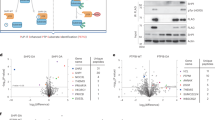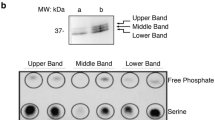Abstract
Sam68 phosphorylation correlates with Fyn but not Lck expression in T cells. This substrate has been used here to explore the possible basis of the specificity of Fyn versus Lck. We show that this specificity is not based on a spatial segregation of the two kinases, since a chimeric Lck molecule containing the membrane anchoring domain of Fyn does not phosphorylate Sam68. Moreover, a Sam68 molecule targeted to the plasma membrane by the farnesylation signal of c-Ha-Ras remains poorly phosphorylated by Lck. In T cells, Fyn appears to be the active Src kinase in rafts, but Sam68 is not expressed in rafts, and its distinct phosphorylation by Fyn and Lck is not affected by raft dispersion. The Fyn/Lck specificity does not reflect a higher kinase activity of Fyn in general, as both Fyn and Lck are similarly recognized by an anti-active Src antibody. Both also strongly phosphorylate another Src substrate in vivo. Mainly, Lck phosphorylates Sam68 when the interaction between the SH3 domain and the SH2-catalytic domain linker is altered in heterologous Src molecules or after mutating key residues in the linker that increase the accessibility of the SH3 domain. Thus, the distinct potential of Fyn and Lck to phosphorylate Sam68 is likely controlled by the interaction of the kinase SH3 domain with the linker and Sam68, possibly on a competitive binding basis.
This is a preview of subscription content, access via your institution
Access options
Subscribe to this journal
Receive 50 print issues and online access
$259.00 per year
only $5.18 per issue
Buy this article
- Purchase on Springer Link
- Instant access to full article PDF
Prices may be subject to local taxes which are calculated during checkout





Similar content being viewed by others

References
Abrams CS, Zhao W . 1995 J. Biol. Chem. 270: 333–339
Alexandropoulos K, Baltimore D . 1996 Genes Dev. 10: 1341–1355
Appleby MW, Gross JA, Cooke MP, Levin SD, Qian X, Perlmutter RM . 1992 Cell 70: 751–763
Barlat I, Maurier F, Duchesne M, Guitard E, Tocque B, Schweighoffer F . 1997 J. Biol. Chem. 272: 3129–3132
Cartwright CA, Eckhart W, Simon S, Kaplan PL . 1987 Cell 49: 83–91
Chen T, Damaj BB, Herrera C, Lasko P, Richard S . 1997 Mol. Cell. Biol. 17: 5707–5718
Cooper JA, Gould KL, Cartwright CA, Hunter T . 1986 Science 231: 1431–1434
da Silva AJ, Li Z, de Vera C, Canto E, Findell P, Rudd CE . 1997 Proc. Natl. Acad. Sci. USA 94: 7493–7498
Davidson D, Chow LM, Veillette A . 1997 J. Biol. Chem. 272: 1355–1362
Feshchenko EA, Langdon WY, Tsygankov AY . 1998 J. Biol. Chem. 273: 8323–8331
Fumagalli S, Totty NF, Hsuan JJ, Courtneidge SA . 1994 Nature 368: 871–874
Fusaki N, Iwamatsu A, Iwashima M, Fujisawa J . 1997 J. Biol. Chem. 272: 6214–6219
Gonfloni S, Frischknecht F, Way M, Superti-Furga G . 1999 Nat. Struct. Biol. 6: 760–764
Gonfloni S, Weijland A, Kretzschmar J, Superti-Furga G . 2000 Nat. Struct. Biol. 7: 281–286
Gonfloni S, Williams JC, Hattula K, Weijland A, Wierenga RK, Superti-Furga G . 1997 EMBO J. 16: 7261–7271
Groves T, Smiley P, Cooke MP, Forbush K, Perlmutter RM, Guidos CJ . 1996 Immunity 5: 417–428
Hartley DA, Hurley TR, Hardwick JS, Lund TC, Medveczky PG, Sefton BM . 1999 J. Biol. Chem. 274: 20056–20059
Hiroaki H, Klaus W, Senn H . 1996 J. Biomol. NMR. 8: 105–122
Itoh K, Sakakibara M, Yamasaki S, Takeuchi A, Arase H, Miyazaki M, Nakajima N, Okada M, Saito T . 2002 J. Immunol. 168: 541–544
Jabado N, Jauliac S, Pallier A, Bernard F, Fischer A, Hivroz C . 1998 J. Immunol. 161: 2798–2803
Kabouridis PS, Janzen J, Magee AL, Ley SC . 2000 Eur. J. Immunol. 30: 954–963
Kawabuchi M, Satomi Y, Takao T, Shimonishi Y, Nada S, Nagai K, Tarakhovsky A, Okada M . 2000 Nature 404: 999–1003
Klages S, Adam D, Class K, Fargnoli J, Bolen JB, Penhallow RC . 1994 Proc. Natl. Acad. Sci. USA 91: 2597–2601
Kmiecik TE, Shalloway D . 1987 Cell 49: 65–73
Lang V, Mege D, Semichon M, Gary-Gouy H, Bismuth G . 1997 Eur. J. Immunol. 27: 3360–3367
Lang V, Semichon M, Michel F, Brossard C, Gary-Gouy H, Bismuth G . 1999 J. Immunol. 162: 7224–7232
Ley SC, Marsh M, Bebbington CR, Proudfoot K, Jordan P . 1994 J. Cell. Biol. 125: 639–649
Marie-Cardine A, Bruyns E, Eckerskorn C, Kirchgessner H, Meuer SC, Schraven B . 1997 J. Biol. Chem. 272: 16077–16080
Marie-Cardine A, Kirchgessner H, Schraven B . 1999 Eur. J. Immunol. 29: 1175–1187
Marie-Cardine A, Verhagen AM, Eckerskorn C, Schraven B . 1998 FEBS Lett. 435: 55–60
Moarefi I, LaFevre-Bernt M, Sicheri F, Huse M, Lee CH, Kuriyan J, Miller WT . 1997 Nature 385: 650–653
Molina TJ, Kishihara K, Siderovski DP, van Ewijk W, Narendran A, Timms E, Wakeham A, Paige CJ, Hartmann KU, Veillette A . 1992 Nature 357: 161–164
Mustelin T, Altman A . 1990 Oncogene 5: 809–813
Mustelin T, Coggeshall KM, Altman A . 1989 Proc. Natl. Acad. Sci. USA 86: 6302–6306
Nada S, Okada M, MacAuley A, Cooper JA, Nakagawa H . 1991 Nature 351: 69–72
Nemorin JG, Duplay P . 2000 J. Biol. Chem. 275: 14590–14597
Okada M, Nada S, Yamanashi Y, Yamamoto T, Nakagawa H . 1991 J. Biol. Chem. 266: 24249–24252
Ostermeyer AG, Beckrich BT, Ivarson KA, Grove KE, Brown DA . 1999 J. Biol. Chem. 274: 34459–34466
Piwnica-Worms H, Saunders KB, Roberts TM, Smith AE, Cheng SH . 1987 Cell 49: 75–82
Prior IA, Harding A, Yan J, Sluimer J, Parton RG, Hancock JF . 2001 Nat. Cell. Biol. 3: 368–375
Qian D, Lev S, van Oers NS, Dikic I, Schlessinger J, Weiss A . 1997 J. Exp. Med. 185: 1253–1259
Richard S, Yu D, Blumer KJ, Hausladen D, Olszowy MW, Connelly PA, Shaw AS . 1995 Mol. Cell. Biol. 15: 186–197
Shen Z, Batzer A, Koehler JA, Polakis P, Schlessinger J, Lydon NB, Moran MF . 1999 Oncogene 18: 4647–4653
Sicheri F, Moarefi I, Kuriyan J . 1997 Nature 385: 602–609
Stein PL, Lee HM, Rich S, Soriano P . 1992 Cell 70: 741–750
Takemoto Y, Furuta M, Li XK, Strong-Sparks WJ, Hashimoto Y . 1995 EMBO J. 14: 3403–3414
Takemoto Y, Sato M, Furuta M, Hashimoto Y . 1996 Int. Immunol. 8: 1699–1705
Taylor SJ, Shalloway D . 1994 Nature 368: 867–871
Torgersen KM, Vang T, Abrahamsen H, Yaqub S, Horejsi V, Schraven B, Rolstad B, Mustelin T, Tasken K . 2001 J. Biol. Chem. 276: 29313–29318
Tsygankov AY, Mahajan S, Fincke JE, Bolen JB . 1996 J. Biol. Chem. 271: 27130–27137
van Oers NS, Lowin-Kropf B, Finlay D, Connolly K, Weiss A . 1996 Immunity 5: 429–436
Vernet C, Artzt K . 1997 Trends Genet. 13: 479–484
Williams JC, Weijland A, Gonfloni S, Thompson A, Courtneidge SA, Superti-Furga G, Wierenga RK . 1997 J. Mol. Biol. 274: 757–775
Williams JC, Wierenga RK, Saraste M . 1998 Trends Biochem. Sci. 23: 179–184
Xu W, Doshi A, Lei M, Eck MJ, Harrison SC . 1999 Mol. Cell. 3: 629–638
Xu W, Harrison SC, Eck MJ . 1997 Nature 385: 595–602
Yamaguchi H, Hendrickson WA . 1996 Nature 384: 484–489
Yang WC, Ghiotto M, Barbarat B, Olive D . 1999 J. Biol. Chem. 274: 607–617
Acknowledgements
We thank Drs A Trautmann, C Randriamampita and V Lang for their critical reading of the manuscript and helpful suggestions. We are grateful to Dr G Superti-Furga for the Src(SH3)Lck construct. This work was supported in part by grants from the Association de la Recherche contre le Cancer and by grants from the Ligue Nationale contre le Cancer. V Feuillet is a recipient of a graduate studentship from the Ministère de l'Education Nationale et de la Recherche. M Semichon is supported by Association Claude Bernard. A Restouin is a recipient of a SIDACTION fellowship. J Harriague is a recipient of a Fondation pour la Recherche Médicale fellowship. J Janzen is supported by Leukemia Research Fund grant 9705.
Author information
Authors and Affiliations
Corresponding author
Rights and permissions
About this article
Cite this article
Feuillet, V., Semichon, M., Restouin, A. et al. The distinct capacity of Fyn and Lck to phosphorylate Sam68 in T cells is essentially governed by SH3/SH2-catalytic domain linker interactions. Oncogene 21, 7205–7213 (2002). https://doi.org/10.1038/sj.onc.1205929
Received:
Revised:
Accepted:
Published:
Issue Date:
DOI: https://doi.org/10.1038/sj.onc.1205929
Keywords
This article is cited by
-
FYN: emerging biological roles and potential therapeutic targets in cancer
Journal of Translational Medicine (2023)
-
Fyn
AfCS-Nature Molecule Pages (2006)


